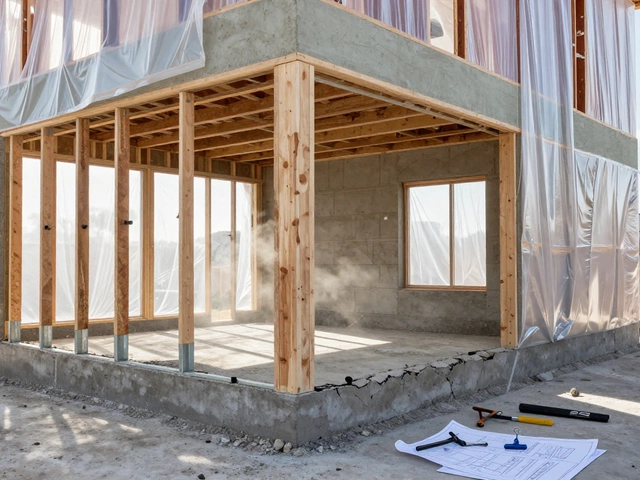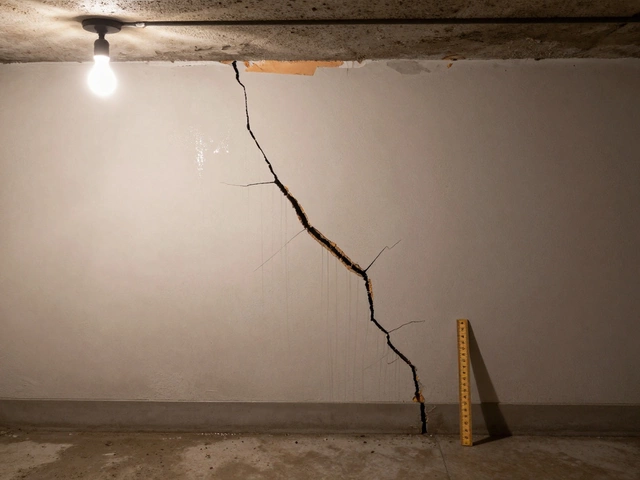If you’ve found a crack running along your basement wall or garage floor, you’re not alone. A ton of homeowners deal with this, but the big question is—do you really need to shell out for pros, or can you actually handle it solo?
It’s not always doom-and-gloom. Foundation cracks come in all shapes and sizes, and not every single one is a big deal. Some can be patched up in a single afternoon. The trick is figuring out what you’re looking at and whether DIY will get the job done safely.
Grab a flashlight, snap a few photos, and let’s break down what you’re dealing with. This isn’t about fancy tools or complicated steps—just clear answers for people who want to know what’s possible, what’s safe, and what’s smart when foundation cracks start showing up.
- Spotting Different Types of Foundation Cracks
- When Is DIY Repair Safe—and When Is It Not?
- What You’ll Need: Tools and Materials
- The Step-by-Step Crack Repair Process
- Common Mistakes to Dodge
- Knowing When to Call a Pro
Spotting Different Types of Foundation Cracks
Before you even think about tackling a foundation crack repair, you gotta know what you’re actually looking at. Not all cracks are the same, and some are just “cosmetic,” while others signal a much bigger problem.
Here’s how you can tell them apart:
- Hairline cracks: These are super thin, like the width of a piece of thread or smaller. They usually pop up in new homes or after your concrete has cured. Most of the time, they’re harmless but still worth sealing to keep out water.
- Vertical cracks: These go straight up and down or at a slight angle (within 30° of vertical). Usually, you see these after the concrete settles a bit. These are often easy to fix yourself with DIY foundation fix methods, as long as they’re not wider than 1/8 inch and not growing.
- Diagonal cracks: These run at an angle. They’re fairly common and often due to minor settling or pressure from soil shifting. Most small or stable diagonal cracks are fine for a solid repair job at home. If they’re wider than 1/4 inch or showing signs of movement, it’s time to pause.
- Horizontal cracks: Now we’re talking serious stuff. These go side-to-side and usually point to big pressure against the wall—like water pressing in from outside. The wider and longer they are, the bigger the risk. These cracks often mean it’s time to step back and get a pro opinion.
- Stair-step cracks: These show up in brick or block foundations and kind of zigzag along the mortar. Small, not-moving ones can sometimes be fixed, but if you notice the wall bulging, get help.
Still not sure? Try tracking the crack with a pencil or a sticky note and check it every couple weeks. If it’s getting longer or wider, you’re likely beyond safe home repair territory. Fun fact: Most small cracks, especially under 1/8 inch wide and not growing, are purely cosmetic and easy for homeowners to patch.
| Type | Safe to DIY? | When to Call a Pro |
|---|---|---|
| Hairline | Yes | If it grows or leaks |
| Vertical | Yes, if stable | If wider than 1/8" or expanding |
| Diagonal | Usually | If wider than 1/4" or worsening |
| Horizontal | Rarely | Almost always |
| Stair-Step | Maybe | If wall bulges or grows |
Look at the size, the direction, and if the crack’s doing anything new. That’s your first clue if a concrete crack is a weekend fix—or a red flag.
When Is DIY Repair Safe—and When Is It Not?
Not every foundation crack repair job is DIY-friendly. The trick is to know the difference between “no big deal” and “call an expert right now.”
So, when is it safe to roll up your sleeves? Hairline cracks that run vertically or at a slight angle are usually the least worrisome. If the cracks are less than 1/8 inch wide and aren’t growing, you can usually seal them up yourself using a DIY foundation fix kit. These cracks usually show up because concrete shrinks as it cures or thanks to harmless minor settling.
| Crack Type | Width | DIY Safe? |
|---|---|---|
| Vertical | < 1/8 inch | Yes |
| Diagonal/slight angle | < 1/8 inch | Possibly |
| Horizontal | > 1/8 inch | No |
| Stair-step (brick/block) | > 1/8 inch | No |
But here’s when you should stop and call a pro:
- Wide cracks: Anything wider than a quarter inch isn’t just a surface crack—it could mean trouble underneath. Same goes if the crack keeps getting bigger.
- Horizontal or stair-step cracks: If the crack is horizontal, or looks like a staircase on a block wall, it usually means pressure from soil outside—and that’s a job for a pro.
- Water leaks: If water is seeping through, your patch job probably won’t hold and there could be bigger moisture problems brewing.
- Doors/windows sticking: If cracks show up with other “weird” stuff—like your doors or windows refusing to open, or sloping floors—don’t risk it. This often points to serious foundation movement.
DIY is totally fine for the simple, small stuff, but skipping expert help when it’s needed can mean way bigger repair bills down the line. A rule of thumb: if something feels off or you can’t tell why it’s happening, getting a professional opinion is always worth it.
What You’ll Need: Tools and Materials
Before you touch that foundation crack repair job, let’s make sure you’ve got the right gear. Skipping something important never ends well—if you try to slap some spackle in there, it’s just going to come right back. So, here’s what you truly need for DIY foundation fix that holds up:
- Safety goggles and gloves – Protect your eyes and hands from dust and sharp edges.
- Wire brush – Scrub out loose concrete, dust, and old paint from the crack.
- Shop vac or hand vacuum – Get debris out of the crack so the repair sticks.
- Chisel and hammer – Open up any hairline cracks just enough for the sealer to grab.
- Concrete cleaner – Helps the repair material bond well.
- Epoxy or polyurethane injection kit – The go-to products for a concrete crack that isn’t moving. Most kits come with nozzles and cartridges to fill deep cracks from inside out.
- Putty knife or trowel – To smooth out the repair surface.
- Painter’s tape – Helps keep the repair neat.
- Bucket and sponge – For cleaning up afterward.
Wondering which products to grab? Home Depot and Lowe’s usually carry foundation crack repair kits from brands like Sika, RadonSeal, or Simpson Strong-Tie. For small, non-structural cracks, hydraulic cement or vinyl concrete patchers from the same brands will do.
"Epoxy injectables have been used in the construction industry for over 40 years. In most cases, an epoxy fill will restore a cracked foundation to its pre-cracked strength." — ConcreteNetwork.com
People sometimes skimp on prep, but this can lead to wasted time and money. A 2023 survey by the International Concrete Repair Institute found that over 50% of DIY repairs fail within two years when the crack isn’t cleaned right before sealing.
| Material | Common Usage (%) |
|---|---|
| Epoxy injection | 62% |
| Polyurethane foam | 28% |
| Hydraulic cement | 8% |
| Other | 2% |
If you’re thinking about tackling home repair yourself, don’t cheap out on materials. Foundation cracks aren’t the place for bargain-bin fix-its. Solid prep and the right products get you results that last.

The Step-by-Step Crack Repair Process
Ready to roll up your sleeves and fix that foundation crack yourself? Here’s exactly how to do it, whether you're working on a crack in poured concrete or block walls. Most cracks under 1/4 inch wide are fair game for DIY foundation fix—anything bigger or leaking? You’ll need a pro.
- Clean the Crack
Start by scooping out loose bits with a screwdriver or wire brush. Don’t skimp here. A dusty crack means your patch won’t stick. - Get Rid of Dust
Hit the area with a shop vac or even a can of compressed air. Extra debris is your enemy. - Apply the Right Product
For small, non-structural cracks, use a concrete crack filler or epoxy. Brands like Quikrete or Sikaflex are made for this and cost about $10–$20 per tube at most hardware stores. - Inject or Trowel
For tubes, cut the nozzle, jam it into the crack, and squeeze—work it in deep. For paste, use a putty knife and press it all the way in, smoothing over the top after. No gaps, no skimping. - Let It Cure
Most fillers and epoxies want at least 24 hours to set up. Some fast-setting brands dry in around two hours, but always check the label for temperature and humidity tips. - Paint or Seal Over
If that crack is in a spot where water sneaks in, add a waterproofer or masonry sealer over the top. It keeps moisture out and helps the repair last.
Here’s a quick snapshot of what you’d typically need for a DIY foundation fix project:
| Item | Purpose |
|---|---|
| Wire brush/screwdriver | Clean out debris |
| Shop vac or air can | Remove dust |
| Epoxy or crack filler | Patch the crack |
| Putty knife/caulking gun | Apply filler |
| Protective gloves | Keep hands safe |
Most folks finish all these steps in under two hours, then wait for the crack to cure. You don’t need a pro background—just patience and a little elbow grease. Want a real hack? Take before-and-after photos to make sure your repair holds up over the next few weeks, especially after heavy rain.
Common Mistakes to Dodge
Trying to fix a foundation crack repair job yourself? There are some classic mistakes people keep making—let’s call them out so you don’t waste money, time, or end up making things worse.
First off, a lot of folks just slap on a bit of concrete patch or paint and call it a day. The thing is, without cleaning and prepping the crack, that patch is going to peel right off the next season. Dust, dirt, or old paint left in the crack kill your chances of the repair actually sticking.
Another big slip-up is using the wrong repair material. Not every crack filler is created equal. There’s a difference between a quick-dry caulk from the hardware store and a proper epoxy or polyurethane injection kit. According to the American Concrete Institute, "Epoxy resins provide a sound structural bond where needed, while flexible polyurethanes are best for dealing with leaks and movement."
"Choosing the right repair material depends on if your foundation needs structural strength or just waterproofing." — American Concrete Institute
It’s also easy to underestimate what you’re up against. Horizontal cracks or ones wider than a quarter inch aren’t for DIY—they often hint at big-time problems like shifting soils or water pressure. Trying to fix these yourself can make things cost even more in the long run.
Forgetting safety is another miss. Some people skip gloves, goggles, or a dust mask, thinking it’s just "a little patch job." Fast-drying epoxy and cement dust are nothing to mess with—protect yourself or you could end up regretting it.
Check out this quick list of what catches most people off guard:
- Not cleaning out the crack deep enough
- Using interior crack fillers for exterior repairs (bad call!)
- Patching over wet cracks or ignoring leaks
- Covering up signs of ongoing movement instead of monitoring them
If you’re not sure about your DIY foundation fix, do a little more reading, or call a pro for a second opinion, especially if you spot water or shifting.
| Common Mistake | Likely Outcome |
|---|---|
| Improper surface prep | Patch peels or fails early |
| Wrong repair material | Repair doesn't hold, leaks return |
| Patching over active cracks | Crack reopens, worsens |
Quick tip: Keep an eye on repaired cracks for a few months. Mark the ends with a pencil—if the crack keeps growing, call for professional help. Foundation fixes are doable, but skipping key steps or ignoring warning signs is what gets most DIY folks in trouble.
Knowing When to Call a Pro
Patching up a small foundation crack might feel doable, but there are times when you really don’t want to mess around with DIY. Some foundation cracks mean there’s a bigger problem—and that’s when it’s smart (and safer) to let a foundation crack repair specialist handle it. Here’s how to spot those situations before things get worse or more expensive.
- Cracks wider than 1/4 inch: If a crack is wider than a pencil, there could be actual movement in your foundation. Anything over a quarter-inch is a big red flag. You want an expert to look at these because quick fixes won’t hold up.
- Diagonal or stair-step cracks: Cracks going at an angle or zig-zagging through your bricks or blocks? This can mean shifting soil or sinking that requires more than just patching. If you see these, snap photos and get a pro involved.
- Cracks that keep growing: Draw a line with a pencil across the crack. If it gets longer or wider over a couple of weeks, that’s not normal. It’s a sign of movement—don’t wait on this one.
- Moisture problems, mold, or musty smells: If you notice water, staining, or weird smells near the crack, you could have drainage issues, which leads to more damage. Experts can spot the real cause and fix it the right way.
- Doors or windows sticking: Are you suddenly having trouble opening or closing doors and windows near the crack? Shifting foundations can throw your whole house off alignment.
- Multiple cracks in the same area: If cracks are popping up all over one wall or floor, it’s usually a sign of a bigger issue—definitely not just surface level.
Here’s a quick look at what calls for pro-level foundation crack repair versus a DIY fix:
| Crack Type | DIY | Call a Pro |
|---|---|---|
| Thin, short, non-growing cracks | ✔️ | |
| Cracks wider than 1/4 inch | ✔️ | |
| Horizontal or stair-step cracks | ✔️ | |
| Multiple cracks/areas | ✔️ | |
| Leaking water or mold | ✔️ |
Also, keep in mind that most states require a certified pro for any foundation crack repair that could affect the house’s structure. Trying to DIY when there’s a structural risk could mess up your insurance or even hurt your home’s value.
So if you’re not sure, or if you see any of this happening, get an inspection before breaking out the concrete patch. It could save you a lot more money and headache down the road.








